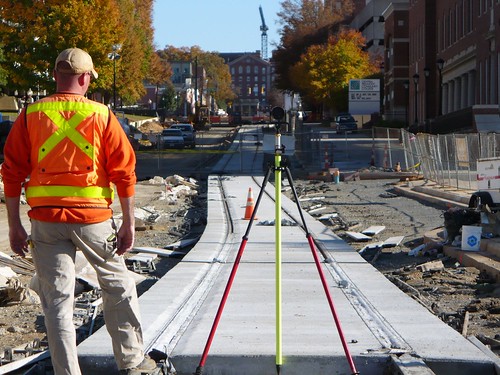The Obama Administration has been a perennial advocate for smart transportation policy, and data from the 2009 stimulus package makes it clear why: these policies create jobs.
 |
| Elizabeth Ave Charlotte Streetcar Construction Survey by Reconnecting America. |
In an article earlier this week, TIME magazine tracked how the Administration has distributed $48 billion for transportation projects included in the 2009 Recovery Act. Writing for TIME, Michael Grunwald explains that most of the transportation funds from the stimulus package have already been pledged to projects:
About 70% of the money is going to highways; the rest is mostly for subways, buses, light rail and other transit projects, plus more than a billion dollars for Amtrak and a similar amount for airports. None of it is going to earmarked projects, and while the impact is not always obvious — most states chose not to erect signs touting the stimulus at construction sites — the work has directly supported an average of 45,800 jobs over the past year.
The jobs angle here is notable: repairing existing roads is a much better economic investment than new road construction. Repair work generates 16% more jobs than new construction, and those jobs are more likely to lead to long term employment. Public transportation projects are even better at creating jobs because they spend less money on land and more on labor, and because projects are often more complex, whether laying track or manufacturing vehicles.
Other parts of the stimulus bill went even further, explicitly stating that transportation, the environment and the economy can all work at the same time. The Transportation Investment Generating Economic Recovery (TIGER) Discretionary Grant Program, which was part of the bill, awarded competitive grants to projects that will improve not only regional transportation, but the environment and the local economy too. Grunwald calls this a “game-changing” program and sees it as the groundwork for “a greener, smarter, safer, more balanced, less congested transportation system.”
This kind of job creation goes a long way to help with economic recovery, and perhaps that’s why President Obama recently announced plans to invest even more in transportation infrastructure. According to the White House, the new plan will focus primarily on repairing existing highways, rehabilitating airplane runways and laying 4,000 of railroad track – enough to reach across the country and then some. In his announcement about the project, Obama called this an investment in “long-term sustainable growth.”
This won’t be the last opportunity the Obama Administration has to weigh in on smart transporation. Congress will be voting this year on a national bill to set federal transportation policy and spending priorities for six years to come, and the Adminstration’s leadership on the bill will be crucial. Smart transportation policy has proven its job creation potential, and is the kind of investment we need to meet the economic challenges of a global economy.
“Where Did the Transportation Stimulus Money Go?” [TIME, September 13, 2010]